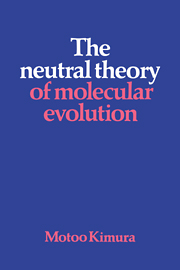The Neutral Theory of Molecular Evolution

The Neutral Theory of Molecular Evolution is an influential monograph written in 1983 by Japanese evolutionary biologist Motoo Kimura. While the neutral theory of molecular evolution existed since his article in 1968,[1] Kimura felt the need to write a monograph with up-to-date information and evidences showing the importance of his theory in evolution.
Content
- From Lamarck to population genetics
- Overdevelopment of the synthetic theory and the proposal of the neutral theory
- The neutral mutation-random drift hypothesis as an evolutionary paradigm
- Molecular evolutionary rates contrasted with phenotypic evolutionary rates
- Some features of molecular evolution
- Definition, types and action of natural selection
- Molecular structure, selective constraint and the rate of evolution
- Population genetics at the molecular level
- Summary and conclusion
See also
Complete reference
- Kimura, M. (1983). The Neutral Theory of Molecular Evolution. Cambridge University Press, Cambridge. ISBN 0-521-23109-4.
References
- ^ Kimura, Motoo 1968. Evolutionary rate at the molecular level. Nature 217, 624–626
